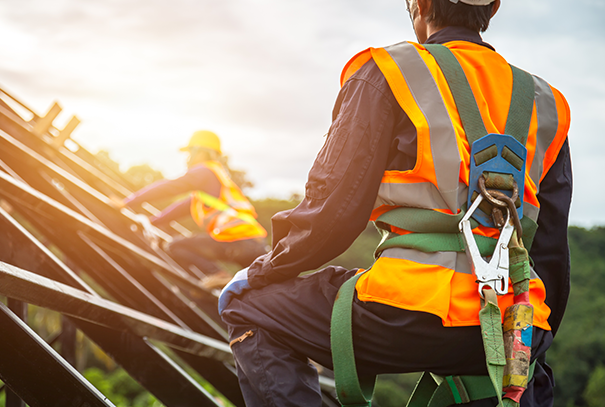
The COVID-19 outbreak has brought with it significant challenges for the construction industry in the UK and Ireland, with Governments in some countries advising the temporary shutdown of some non-essential construction projects. Those construction companies who have chosen to shut down must act quickly to comply while adhering to legal obligations.
Now that the dust has settled on the process of shutting down a construction site, your focus may turn to legal and health and safety obligations. It’s important to consider the protection of your equipment, tools and materials as the United Kingdom Construction Equipment Association reported a 50% increase in theft within the first two weeks of lockdown1.
A carefully considered shutdown can help keep your site secure, whilst preparing your business for normal service to resume once the imposed restrictions are lifted.
Risk assessment and inspection
Conducting a risk assessment to determine potential exposures to loss may be prudent move. The assessment should outline risks to property and equipment, neighbouring properties and residents, and also potential trespassers. If no work is to be performed during shutdown, a risk assessment report would usually provide an estimated site closure and reopening time frame, which in the current circumstances will need to remain fluid.
If it is deemed safe to do so, arrange an onsite inspection now that shutdown has commenced. The purpose of an onsite inspection is to identify conditions that could result in loss during the shutdown. The more comprehensive the inspection the better – take photographs, videos and make detailed notes on each area of the site. The inspection should include things such as points of access to the site, any equipment that has remained in place, and storage of construction materials. Losses to consider should include property damage, construction defects, and bodily injury.
The findings from your risk assessment and inspection will become the foundation of your written site control plan.
Site access and security
Extra security may be necessary during the shutdown period, whether that’s staff or additional security measures such as CCTV or locks and alarms. Your risk assessment will have determined any areas that may need reinforcement, or any systems that need repair or maintenance.
If any essential work or maintenance needs to be done intermittently during shutdown, or if you are arranging site inspections during this time, take into account site access and safety protocols for authorised personnel. Verbal and written safety warnings (including onsite signage) should be clear and accurate.
Other aspects to consider are location-specific exposures such as weather, theft or vandalism, as well as accessibility to the emergency services.
Materials and equipment
Ask subcontractors to remove non-essential tools and equipment from the site, if they have not done so already, and secure any remaining items in locked containers or an offsite compound if possible. Protect immovable equipment with tarpaulin covers, and materials with protective wrap to minimise contact with moisture.
Any materials and equipment left onsite during shutdown should be inventoried, and inspected/tested prior to use once the site reopens.
Cranes
Ensure tower cranes are in free slew mode, free from chains and slings, and the aviation lights are operational. If possible, lower lattice boom cranes and fully retract telescopic booms. If this was not done before shutdown, initiate a process of frequent checks for boom creep, eroding ground conditions and vandalism, and monitor weather that may mean lowering booms becomes essential.
Scaffolding
Verify that all scaffolding is secured and inaccessible, with all ladders removed. Scaffolding should be inspected throughout the duration of the shutdown at regular intervals to check for damage or vandalism, and before and after extreme weather events.
Excavations and site drainage
Open excavations should be back-filled, covered or barricaded, and checks scheduled during shutdown to ensure that there is no risk of collapse and no exposed reinforcing steel. Trenches and drains should also be covered or barricaded if necessary.
Water and weather intrusion
Consider how to close up openings that leave buildings exposed to the weather. Board up window and doors if possible, inspect permanent and temporary roofing, and check gutters and drainage systems. Seal or install curbs on all slab penetrations to prevent floor-to-floor water transmission. Assign personnel to monitor weather throughout the shutdown and establish protocols for weather event responses to minimise site damage.
Fire prevention
Ensure fire detection and suppression systems are in place and monitored throughout the shutdown period. Identify sources of ignition such as electrical systems and temporary heating, and document all actions taken to remove, isolate and protect fuels, combustibles and flammables. Review everything in line with your project’s existing fire prevention plan.
Documentation
Maintain all documentation related to the shutdown, including risk assessments, inspections, photographs, control plans and correspondence with project personnel, during preparation for and throughout inactive periods.
Even though the shutdown has commenced, it’s still important to check with your insurance provider of any insurance requirements or considerations. Many insurance policies, in particular property policies and contractors all risks policies, have terms and conditions that apply when works cease on a site, or when a property such as an office is no longer occupied for an extended period of time. You may wish to check with your insurance provider whether they can agree with the underwriter a degree of flexibility, where possible, in restrictions of cover due to cessation of works.
Lastly, now that sites and premises are shut down, consider actions and decisions that will help your business and personnel respond quickly to a surge in the market once construction resumes.
- CEA – UK site theft up by half, Demolition and Recycling International, 7th April 2020 - https://www.khl.com/demolition-and-recycling-international/cea-uk-site-theft-up-by-half/143328.article


